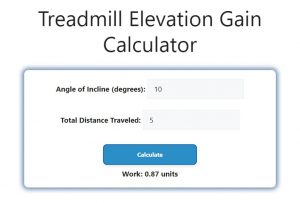About Treadmill Elevation Gain Calculator (Formula)
The Treadmill Elevation Gain Calculator is a handy tool for fitness enthusiasts and trainers looking to track and enhance their workout routines. Elevation gain, or the vertical distance covered during exercise, is an essential metric for assessing the intensity and effectiveness of a workout. By understanding how incline affects elevation gain, users can tailor their treadmill workouts to achieve specific fitness goals, whether for weight loss, endurance training, or building strength.
Formula
The formula used in the Treadmill Elevation Gain Calculator is: EG = SIN(IA) * D, where EG represents the elevation gain, IA is the angle of incline in degrees, and D is the total distance traveled. This formula uses the sine function to calculate the vertical gain based on the angle of incline and distance.
How to Use
Using the Treadmill Elevation Gain Calculator is simple and involves the following steps:
- Input Angle of Incline (IA): Enter the incline angle of the treadmill in degrees. This angle represents how steep the treadmill is set for your workout.
- Input Total Distance Traveled (D): Enter the total distance you plan to run or walk on the treadmill, measured in meters or kilometers.
- Calculate: Click the “Calculate” button to determine the elevation gain. The calculator will compute the vertical distance gained based on the provided inputs.
Example
To illustrate how the Treadmill Elevation Gain Calculator works, consider the following example:
- Angle of Incline (IA): 10 degrees
- Total Distance Traveled (D): 5 kilometers
Using the formula:
EG = SIN(IA) * D
EG = SIN(10 degrees) * 5 km
EG ≈ 0.1736 * 5 km
EG ≈ 0.868 km
In this example, the elevation gain is approximately 0.868 kilometers, indicating how much vertical distance you would gain while walking or running on a 10-degree incline for 5 kilometers.

FAQs
1. What is elevation gain?
Elevation gain refers to the total vertical distance ascended during a workout, typically expressed in meters or feet.
2. Why is elevation gain important?
Tracking elevation gain helps gauge workout intensity, assess progress in fitness goals, and improve overall cardiovascular health.
3. How do I determine the angle of incline?
The angle of incline is usually provided by the treadmill settings. It is often adjustable and measured in degrees.
4. What units can I use for total distance traveled?
You can enter the total distance in either meters or kilometers, depending on your preference.
5. Can the calculator be used for outdoor workouts?
While primarily designed for treadmill workouts, the calculator can also apply to outdoor activities with similar incline measurements.
6. Is there a maximum angle of incline I can enter?
Most treadmills have a maximum incline, typically between 10 to 15 degrees. Check your treadmill specifications for details.
7. How does incline affect calorie burn?
Higher inclines typically lead to increased calorie burn due to the added effort required to overcome gravity.
8. Can I use the calculator for running and walking?
Yes, the calculator is suitable for both running and walking workouts.
9. What if I input the wrong values?
You can easily re-enter the correct values and recalculate for accurate results.
10. Does the calculator account for speed?
No, the calculator focuses on elevation gain based on distance and incline, not speed.
11. How can I improve my treadmill workouts using elevation gain?
Incorporating varying inclines into your routine can help enhance strength, endurance, and cardiovascular fitness.
12. Is it possible to achieve a negative elevation gain?
No, elevation gain is always a positive value, representing ascent. A decline would be considered a negative elevation change.
13. Can I track elevation gain over multiple workouts?
Yes, you can record the elevation gains from multiple sessions to track your progress over time.
14. Is the sine function used in other fitness calculations?
Yes, the sine function is commonly used in various fitness and physics calculations involving angles and distances.
15. How accurate is the Treadmill Elevation Gain Calculator?
The calculator’s accuracy relies on the precision of the inputs you provide.
16. What is the relationship between incline and elevation gain?
A steeper incline results in greater elevation gain for the same distance traveled.
17. Can I use the calculator for stair climbing workouts?
Yes, the principles apply similarly, as stair climbing also involves elevation gain based on the incline and distance.
18. How can I incorporate elevation gain into my fitness routine?
Consider adding incline intervals into your treadmill sessions to boost intensity and challenge your muscles.
19. Is it safe to use high inclines for extended periods?
Consult with a fitness professional if you’re unsure, especially if you have pre-existing health conditions or injuries.
20. Where can I find more resources on treadmill workouts?
Many fitness websites, apps, and gym resources offer guidelines and tips for effective treadmill workouts and incline training.
Conclusion
The Treadmill Elevation Gain Calculator is an invaluable tool for anyone looking to enhance their workout efficiency and measure vertical progress. By understanding how to manipulate incline and distance, users can create more challenging and effective treadmill routines tailored to their fitness goals. Whether you’re a beginner or an experienced athlete, leveraging elevation gain can significantly impact your training outcomes and overall fitness journey.
